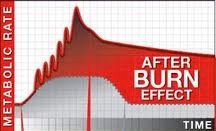 |
We all know by now that we continue to burn fat after a hard strength training session but do you know why? It’s called EPOC – excess post exercise oxygen consumption, read my article below to learn more and motivate yourself to train harder…. |
|
After strength training, our body needs oxygen at a higher rate than before the exercise began. This sustained oxygen consumption is known as EPOC. After training we need to replace the oxygen used by working muscles during intense bouts of exercise. Recently, researchers have used the term EPOC to describe the several different events that occur as the body restores itself to homeostasis (normal state). During EPOC the body restores itself to its pre-exercise state, therefore consuming oxygen at an elevated rate. This means that energy is also being expended at an elevated rate. During EPOC the following occurs
Strength training produces greater EPOC response than aerobic exercise (cardio) as high intensity resistance training disturbs the body’s homeostasis to a greater degree than aerobic exercise and the result is a larger energy requirement after training to restore the bodies systems to normal as explained above. The underlying mechanisms that cause the higher EPOC in resistance training include elevated blood lactate, an increase in circulating catecholamine’s (epinephrine and norepinephrine) and anabolic hormones. After reading this you will understand that it is imperative to ensure you are on a correct nutritional and supplemental protocol from your specialist, and that in each and every training session you are taking it to the Xtreme. Ash Mason – Xtreme Results Personal Training and Nutrition. |
